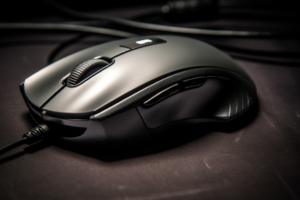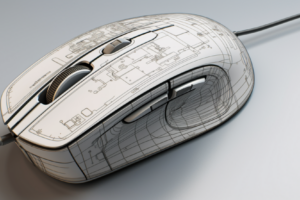What Is A Computer Mouse?
The computer mouse, a quintessential input device, is a tool that computer users interact with to command a computer system.
It’s indispensable for navigating the graphical user interface, allowing you to move the mouse cursor on your computer screen with ease. The device’s name is inspired by its shape and the long cord that connects it to the computer, resembling a mouse and its tail.
Developed in the 1960s by the Stanford Research Institute, the first computer mouse was a mechanical mouse, also known as a “ball mouse.” The first public demonstration of a mouse controlling a computer system was in 1968, as detailed in this Wikipedia article. The first production workstation and mouse were made in 1967, according to this source.
In our experience at HotHeadTech.com as IT support specialists, we’ve seen firsthand how the evolution of the computer mouse has impacted user experience and productivity.
This design used a ball that, when rolled on a flat surface, transmitted x-y position indicators to the computer. This mechanism enabled the computer system to track the computer mouse movements and translate them to the movement of the cursor on the display screen.
The development of the mouse began in the early 1960s by SRI International, which significantly changed how humans interact with computers. More about this can be found here.
The first computer mouse was invented by Douglas Engelbart in 1964. It was designed as a wooden box, with two metal wheels that make contact with the surface. You can read more about this here.
From Ball Mouse to Optical Mouse
Tthe ball mouse had its drawbacks, including the need for regular cleaning due to dirt accumulation inside the computer mouse. Thus, the optical mouse was invented, providing computer users with improved precision and reliability.
At HotHeadTech.com, we’ve helped many users transition from ball mice to optical mice, and we’ve seen the significant improvements in precision and reliability that this change brings.
The way an optical mouse works is by emitting light from an LED or a small laser to a surface, which is then reflected back to a sensor.
This sensor translates the changes in reflection into electronic signals, which are transmitted to the computer as mouse signal information. As a result, the mouse cursor moves on the computer screen in accordance with the mouse’s movement.

Different Types of Computer Mice
There are different types of computer mice, each with their distinct mouse features. For example, the laser mouse uses a laser beam instead of an LED, providing greater sensitivity.
Then we have the wireless mouse, a favorite among desktop computer users, which eliminates the need for a cord.
Wireless mice connect to the computer using radio signals, via a USB receiver plugged into the computer’s USB port. This wireless signal offers a degree of freedom and flexibility that a wired mouse cannot.
As IT support specialists at HotHeadTech.com, we often recommend wireless mice to our clients for their convenience and flexibility, especially for those who need to maintain a clutter-free workspace.
Different types of computer mice can also be categorized based on connectivity and sensing, as explained in this article.
Wired Mouse and Trackball Mouse
The wired mouse, or a corded mouse, provides a direct wired connection to the computer.
In our experience at HotHeadTech.com, we’ve found that wired mice are often preferred by gamers and professionals who require a more consistent connection, reducing the chances of signal interruption.
These wired mice are often preferred by gamers as they ensure a more consistent connection, reducing the chances of signal interruption that might occur in a wireless mouse. USB mice are common, but other interfaces also exist.
Another variant is the trackball mouse, where the ball is exposed and can be controlled by the user’s fingers. For more details on different types of mice, including the trackball mouse, you can refer to this source.
A trackball mouse stays stationary, and the cursor on the screen is navigated by rotating the ball. This type of computer mouse can be wired or wireless.
For a more comprehensive understanding of the different types of computer mice, you can refer to this source. It provides a detailed overview of various types of mice, including mechanical, optical, laser, and wireless mice.
Computer Mouse Buttons and Their Functions
Typically, a mouse will have at least two mouse buttons: the left mouse button, controlled by the index finger, and the right mouse button, controlled by the middle finger.
Some mice also feature a third mouse button, often in the form of a scroll wheel located between the left and right buttons. This mouse wheel can be used to scroll up and down pages on the screen, and in some cases, can be clicked as a third mouse button.
The computer mouse pointer’s sensitivity, or how far the cursor moves in response to the mouse movement, can be adjusted in the computer’s settings.
Some computer mice also come with additional buttons that can be programmed to perform other functions, such as ‘forward’ and ‘back’ in a web browser. For a visual understanding of the different types of computer mice, you can refer to this source, which provides pictures and descriptions of ten different types of computer mice.
Specialized Computer Mice and Use Cases
The mouse is typically used on a desk or a mouse pad. However, there are variations to this norm.
Vertical and Gaming Mice
For example, the vertical mouse, designed to be held in a “handshake” position, can reduce wrist strain.
The gaming mouse, designed specifically for video gamers, often has additional buttons for game-related functions and may offer a higher level of sensitivity adjustment.
Air Mouse and Trackpad
An interesting variation is the upside-down mouse, or the “air mouse,” which can be used without a flat surface and instead relies on wave gestures in the air. The computer mouse sensitivity in these models is often adjustable, like in traditional mice.
In laptop computers, the trackpad, also known as a touchpad, serves as the mouse. It allows users to move the mouse pointer across the screen by dragging their fingers across a smooth surface.
This device also often includes features that mimic mouse buttons and the scroll wheel, enabling users to click, right-click, and scroll through pages.
Computer Mouse Design and User Comfort

The design and functionality of computer mice vary greatly. For instance, the Apple computer mouse, also known as the “Magic Mouse,” boasts a sleek design with a multi-touch surface that allows for gesture-based interaction, similar to the touch screen of an iPhone or iPad.
The Importance of Computer Mouse Design
The design of a computer mouse is significant, especially when considering the comfort of the user. For an overview of different types of computer mice, including ergonomic mice designed for comfort, you can refer to this source.
At HotHeadTech.com, we understand the importance of user comfort. We’ve helped numerous clients choose the right mouse design that suits their needs and reduces strain during prolonged computer use.
The typical computer mouse has evolved over the years, with many variations that cater to different user needs.
For example, a vertical mouse is designed to reduce strain during prolonged computer use, while a gaming mouse might include additional buttons and high-precision tracking for a competitive edge in video games.
Specialized Computer Mice for User Comfort
Most desktop mice require a flat area to operate effectively, but there are exceptions. For instance, an upside-down mouse or “air mouse” can be used in environments where a flat surface is not available, such as during a presentation.
These mice often feature additional buttons and controls, such as volume adjustment, making them particularly useful for controlling a computer from a distance.
There’s also a distinct category for multiple computer mice, where more than one computer mouse is used simultaneously on a computer.
This might be useful in collaborative work environments, where two or more users need to interact with the same computer system.
Connecting the Computer Mouse to the Computer: Wired vs Wireless
As for how these mice connect to the computer, we have wired and wireless mouse options. For a list of 11 different types of computer mice, including wired, wireless, and Bluetooth mice, you can refer to this source.
At HotHeadTech.com, we’ve assisted many clients in setting up both wired and wireless mice, and we can attest to the benefits and drawbacks of each based on the specific needs of the user.
Wired Computer Mouse: Pros and Cons
A wired mouse, also referred to as a corded mouse or USB mouse, connects directly to the computer, typically through a USB port.
This connection type is common among desktop computers and provides a reliable and lag-free response.
Wired mice, such as gaming mice, often come with additional features like customizable buttons and adjustable sensitivity.
Wireless Mouse: Pros and Cons
Wireless mice, on the other hand, connect to the computer using a wireless signal. Some wireless mice use a small USB receiver that plugs into the computer’s USB port, while others may use Bluetooth technology.
A wireless mouse offers the advantage of freedom of movement and a clutter-free workspace without the cords. They are popular with laptop users and those who prefer a cleaner, wire-free setup.
The Role of the Computer Mouse in Interacting with a Computer Interface
Regardless of the type, all mice serve the same basic function: to move the cursor and interact with the computer’s graphical user interface.
Moving the Cursor: The Basic Function
The computer mouse cursor acts as an extension of our hand, allowing us to point, click, drag and drop items on the screen. The cursor’s position corresponds to the mouse’s movement on a flat surface, with the mouse’s sensitivity determining the speed at which the cursor moves.
Computer Mouse Buttons: Enhancing Interaction
The mouse buttons are an integral part of the device’s functionality. The left button is used for primary clicks, such as selecting items and triggering actions within a computer program.
The right button is typically used to access context-specific menus. Some computer mice also include a third mouse button, often incorporated into the scroll wheel, which can be used for additional functions like opening new tabs in a web browser or activating certain features in a software application.
The scroll wheel, located between the left and right mouse buttons, is used to scroll up and down on a page. Some scroll wheels can also tilt left or right for horizontal scrolling, and as mentioned earlier, can sometimes function as a third mouse button.
This feature has become standard in most computer mice and is particularly useful when navigating long documents or web pages.
Conclusion: The Importance of the Computer Mouse
In conclusion, the computer mouse is a critical input device that allows users to interact with their computers effectively and intuitively.
Whether it’s an optical mouse, a laser mouse, a wireless mouse, or a wired mouse, each serves the purpose of enhancing the user’s control over their computer system.
In our experience at HotHeadTech.com, we’ve seen how the right computer mouse can significantly enhance a user’s control over their computer system and improve their overall experience.




Comments are closed